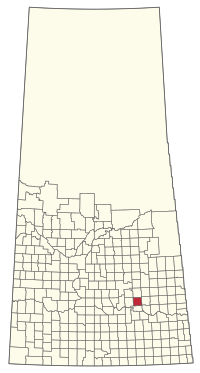Rural Municipality of Lipton No. 217
Lipton No. 217 | |
|---|---|
| Rural Municipality of Lipton No. 217 | |
 Location of the RM of Lipton No. 217 in Saskatchewan | |
| Coordinates: 50°57′07″N 103°53′24″W / 50.952°N 103.890°W[1] | |
| Country | Canada |
| Province | Saskatchewan |
| Census division | 6 |
| SARM division | 1 |
| Formed[2] | December 11, 1911 |
| Government | |
| • Reeve | Corey Senft |
| • Governing body | RM of Lipton No. 217 Council |
| • Administrator | Frank Kosa |
| • Office location | Lipton |
| Area (2016)[4] | |
| • Land | 813.69 km2 (314.17 sq mi) |
| Population (2016)[4] | |
• Total | 381 |
| • Density | 0.5/km2 (1/sq mi) |
| Time zone | CST |
| • Summer (DST) | CST |
| Area code(s) | 306 and 639 |
The Rural Municipality of Lipton No. 217 (2016 population: 381) is a rural municipality (RM) in the Canadian province of Saskatchewan within Census Division No. 6 and SARM Division No. 1.
History
[edit]The RM of Lipton No. 217 incorporated as a rural municipality on December 11, 1911.[2]
- Heritage properties
There are three historical sites located within the RM.
- Hayward School – Constructed in 1904–1952, the site contains a one-room school house and barns.[5]
- Lipton Jewish Cemetery – Established in 1902, the cemetery is the resting place for early Jewish immigrants.[6]
- Tomecko House – Constructed in 1917–18, by Mr. Stephen Tomecko, the house served as a gathering place for dances after harvest.[7]
Fort Qu'Appelle-Touchwood Hills Trail
[edit]A section of the Carlton Trail[8] from the Touchwood Hills[9] to the Fishing Lakes in Qu'Appelle Valley was called the Fort Qu'Appelle-Touchwood Hills Trail[10] and a portion of it passed through the RM of Lipton No. 217. The route was used regularly by traders, settlers, Métis, and First Nations from the 1850s until 1890 when the railway came through the area. The Dominion Telegraph line was built alongside the trail. In 1885 General Frederick Middleton used this trail with his column of militia en route to Batoche, Saskatchewan during the North-West Rebellion. After the completion of the railway, the trail continued to be used by locals. Eventually, though, with the introduction of the automobile, the trail, and many others like it, fell into disuse and were often ploughed over.[11]
A section of the Fort Qu'Appelle-Touchwood Hills Trail is commemorated as a historic site alongside Highway 35 north of the town of Fort Qu'Appelle in the RM of Lipton No. 217. The site has a cairn and is .13 ha (0.32 acres) in size. Ruts from the Red River carts can still be seen in the prairie grass by the site.[12]
Geography
[edit]Communities and localities
[edit]The following urban municipalities are surrounded by the RM.
It also surrounds the Village of Dysart.
Demographics
[edit]In the 2021 Census of Population conducted by Statistics Canada, the RM of Lipton No. 217 had a population of 388 living in 168 of its 191 total private dwellings, a change of 1.8% from its 2016 population of 381. With a land area of 805.35 km2 (310.95 sq mi), it had a population density of 0.5/km2 (1.2/sq mi) in 2021.[15]
In the 2016 Census of Population, the RM of Lipton No. 217 recorded a population of 381 living in 158 of its 189 total private dwellings, a -10.1% change from its 2011 population of 424. With a land area of 813.69 km2 (314.17 sq mi), it had a population density of 0.5/km2 (1.2/sq mi) in 2016.[4]
Government
[edit]The RM of Lipton No. 217 is governed by an elected municipal council and an appointed administrator that meets on the first Tuesday of every month.[3] The reeve of the RM is Corey Senft while its administrator is Frank Kosa.[3] The RM's office is located in Lipton.[3]
See also
[edit]References
[edit]- ^ "Pre-packaged CSV files - CGN, Canada/Province/Territory (cgn_sk_csv_eng.zip)". Government of Canada. July 24, 2019. Retrieved May 23, 2020.
- ^ a b "Rural Municipality Incorporations (Alphabetical)". Saskatchewan Ministry of Municipal Affairs. Archived from the original on April 21, 2011. Retrieved May 9, 2020.
- ^ a b c d "Municipality Details: RM of Lipton No. 217". Government of Saskatchewan. Retrieved May 21, 2020.
- ^ a b c "Population and dwelling counts, for Canada, provinces and territories, and census subdivisions (municipalities), 2016 and 2011 censuses – 100% data (Saskatchewan)". Statistics Canada. February 8, 2017. Retrieved May 1, 2020.
- ^ Hayward School
- ^ Jewish Cemetery
- ^ Tomecko House
- ^ Hall, Frank. "Carlton Trail—First Western Highway". Manitoba Historical Society. Retrieved April 29, 2022.
- ^ "Touchwood Uplands". Canadian Geographical Names Database. Government of Canada. Retrieved April 29, 2022.
- ^ "Fort Qu'Appelle-Touchwood Hills Trail Historic Site". Canadian Geographical Names Database. Government of Canada. Retrieved April 29, 2022.
- ^ "Fort Qu'Appelle - Touchwood Hills Trail Provincial Historic Site". Canada's Historic Places. Parks Canada. Retrieved April 29, 2022.
- ^ "Fort Qu'Appelle-Touchwood Hills Trail - Saskatchewan Historical Markers". Waymarking. Groundspeak, Inc. Retrieved April 29, 2022.
- ^ "Saskatchewan Census Population" (PDF). Saskatchewan Bureau of Statistics. Archived from the original (PDF) on September 24, 2015. Retrieved May 9, 2020.
- ^ "Saskatchewan Census Population". Saskatchewan Bureau of Statistics. Retrieved May 9, 2020.
- ^ "Population and dwelling counts: Canada, provinces and territories, census divisions and census subdivisions (municipalities), Saskatchewan". Statistics Canada. February 9, 2022. Retrieved April 13, 2022.

